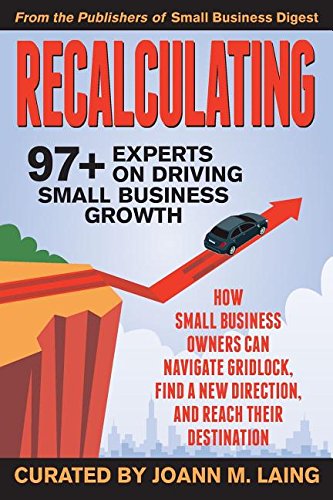Motivating people is both a science and an art!
/in Business Advice, Entrepreneurship, Management Advice/by Michael Gansl
Since the tag line for Voice of Reason Consulting is “We Turn Business Owners into CEOs”, I was absolutely drawn to an article about “The Science of Pep Talks” by Daniel McGinn in the July-August 2017 issue of the Harvard Business Review.
McGinn postulates that the ability to deliver an energizing pep talk that spurs employees to better performance is a prerequisite for any business leader, and I believe is also a key factor in judging a CEO’s performance as the leader of his/her company.
Motivating people is both a science and an art! According to the science (MLT- motivating language theory) most winning formulas include three key elements: direction giving, expressions of empathy, and meaning making.
The Mayfields, a husband/wife research team from Texas A&M University describe “direction giving” as providing information about precisely how to do the task, giving easily understandable instructions, providing good definitions of tasks, and letting people know how their performance will be evaluated. “Empathetic language” is showing concern for the person as a human being, and includes praise, encouragement, gratitude, and acknowledgment of a task’s difficulty. “Meaning-making language” explains why a task is important. This involves linking the organization’s purpose or mission to listeners’ goals.
Bottom line, a good pep talk—whether delivered to one person or many—should include all three elements. It’s the job of the CEO to know the context and the audience in order to determine the right mix of these three elements. Once leaders and CEOs understand these three elements, they can learn to use them more skillfully.
I urge you to read the entire article and let me know what you think.
Want More Leaders in Your Organization?
/in Business Advice, Investment, Management Advice/by Michael Gansl
As a long time student of sales I am especially interested in developing compensation plans to motivate and inspire salespeople to become high producers. That being said, I was delighted to receive my weekly Business Insights newsletter from the Stanford Graduate School of Business that summarized a new study, coauthored by Kathryn Shaw of Stanford Graduate School of Business, and Ann Bartel of Columbia Business School and Brianna Cardiff-Hicks of Cornerstone Research that sheds light on encouraging high producers to become good leaders.
This particular study looked at a high-powered law firm founded in the 1990s, and grew rapidly for over fifteen years relying almost entirely on an eat-what-you-kill system.
In its purest from, eat-what-you-kill means basing the size of a person’s paycheck almost entirely on how much business that person brings in. Shaw and her colleagues wanted to see what happened when this law firm switched from an almost pure eat-what-you-kill approach to one that rewards work that benefits the firm as a whole.
My partner Matt Plociak is a firm believer that money, and that being on full commission should motivate salespeople or in this case, even lawyers should be compensated an eat-what-you-kill basis.
So the question in this study of the law firm is whether the shift from eat-what-you-kill improved the long-run strength of the firm by having the senior attorneys invest more effort on the organization as a whole. The belief by some of our colleagues is that at some point, even fast-growing companies need more than big producers. They need leaders who will invest time and effort on the big picture. They need people who can bring out the best in employees, communicate a vision, or build the firm’s public reputation. And this necessarily, begs the question as to how to structure incentives that focus on the big picture, and still generate increasing revenues.
The data collected in this study may not be totally conclusive enough to offer a definitive judgment, but it does indicate that the law firm did make better use of their junior associates who had been underutilized under the old system, which ultimately resulted in a win-win for all the attorneys in the firm.
To be sure, Shaw says, companies of all types still want ambitious go-getters who dream of big paychecks, but encouraging people to work for the good of the whole organization can be a winning strategy for everyone. I’m curious as to what you think. I look forward to your comments.
How to Prepare for an Automated Future
/in Business Advice, Management Advice/by Michael Gansl
With all the talk about jobs swirling about, I was very interested in this article, How to Prepare for an Automated Future by Claire Cain Miller which appeared in the NY Times, The Upshot, May 4, 2017.
Given the considerable concern for jobs in the future, Claire Cain Miller postulates that the logical response might include educating people differently so they would work actually alongside machines and robots.
In a recent survey of 1048 technology and education workers who were asked if they thought new schooling will emerge in the next decade to successfully train workers for the future, two-thirds said yes and the rest said no.
Here are some of the highlights of their responses to the survey:
- People still need to learn skills, but they will do that continuously over their careers. In school, the most important thing they can learn is how to learn.
- Schools will also need to teach traits that machines can’t yet easily replicate, like creativity, critical thinking, emotional intelligence, adaptability and collaboration.
- About two-thirds of the respondents thought changing education fast enough to outpace machines could be done in the next decade; while the rest thought that education reform takes too much time, money and political will, and that automation is moving too quickly.
- Many survey respondents said a degree was not enough — or not always the best choice, especially given its price tag. Many of them expect more emphasis on certificates or badges, earned from online courses or workshops, even for college graduates.
- Employers will also place more value on on-the-job learning, such as apprenticeships or on-demand trainings at workplaces.
So, what do you think? How can we prepare for jobs in the future? I welcome your responses.
Private Equity Growth Indicators
/in Entrepreneurship, Management Advice/by Michael Gansl
A current theme that continues to occupy my interest is how private equity/venture and angel investors view businesses and judge CEO’s. In a recent post, I discussed a Stanford Business Graduate School study “How Do Venture Capitalists Make Decisions?” that showed that venture capitalists who are considering investing in entrepreneurial ventures, are most interested in entrepreneurs who are passionate, capable, experienced, and part of a strong team.
In this particular article in the Sales Benchmark Index Blog earlier this month, Matt Sharrers discusses the growth indicators a private equity firm expects. He points out that the end of first quarter is an ideal time for private equity firms to check each of their portfolio company’s growth rates, including sales and marketing performance.
According to Sharrers, private equity firms are most interested in implementing an agile sales and marketing strategy focused on results. Q1 is a decision making time to validate prior assumptions as well as the actual results, and most importantly make new decisions as necessary.
Leading indicators include whether sales and marketing are working in lock step and whether sales and marketing are enabled to hit their growth milestones.
Of course, private equity firms are very wary of red flags that exclude win/loss analyses, provide inaccurate market feedback, and show a lack of confidence in Q2 forecasts.
In particular, the CEO must demonstrate that sales and marketing are always in alignment, and there is always a clear plan to execute strategy and do it quickly. As I have often said, the CEO’s job is to provide value for the business, and you can rest assured that the job of the private equity firm is to ensure that value is being achieved.
How Do Venture Capitalists Make Decisions?
/in Business Advice, Entrepreneurship, Investment, Management Advice/by Michael Gansl
The other day I came across one of my favorite newsletters from The Stanford Business Graduate School, and in particular the subject line “Do Funders Care More About Your Team, Your Idea, or Your Passion?” intrigued me to read on.
In a study co-authored by Stanford finance professor Ilya A. Strebulaev, “How Do Venture Capitalists Make Decisions?” The findings seem to indicate that Venture Capitalists who are considering investing in entrepreneurial ventures, are most interested in entrepreneurs who are passionate, capable, experienced, and part of a strong team.
The survey included 885 Venture Capital professionals at 681 firms, and asked the VCs to identify the factors that drove their investment selection decisions and ranked them according to importance. The abilities of a founder and his/her management team are the most important factors driving investment decisions, and even more important than the product or technology itself.
The average investor evaluates 200 companies a year and invests in just four. Each deal takes an average of 83 days to put together, which includes 118 hours of due diligence and Strebulaev says that “Venture Capitalists gauge an entrepreneur’s passion level by their commitment of time, effort, and money to their idea. “
The study was structured in a way that enabled researchers to better understand how different types of venture capital investors approach their decisions. They found that information technology investors tend to be interested in an entrepreneur’s management team, while health sector investors are more interested in products and market forces.
If indeed you have the time, I strongly recommend downloading the complete study HERE.
As usual, please email me your thoughts and comments. I guarantee you a response!
Reflections and Outlook
/in Management Advice/by Michael Gansl
During the months of December 2016 and January 2017, I had the opportunity to present “REFLECTIONS FOR THIS PAST YEAR AND OUTLOOK FOR THE COMING NEW YEAR” to over 100 people in 13 different networking groups.
In the workshop we asked each other what were our professional accomplishments as well as our professional disappointments in the prior year.
We also asked one another to reflect on the one thing to stop doing, and the one thing to start doing in the coming year to become a more effective leader in each of our own companies.
Lastly, we asked ourselves to list our three Professional Performance Objectives and Milestones for the coming year with our anticipated Specific Outcomes and Results with the Dates to be Completed by.
The ultimate goal of this interactive workshop was to create a “roadmap/top down business plan” which each individual could review as they saw fit, in order to make the new year as successful as it could possibly be.
On a personal level, it was a great learning opportunity for me, and I truly appreciated everyone’s candor, honesty and willingness to share their experiences in a group setting.
I also wanted to thank Dave Bresler, Steve Percudani, Paul Berkman, Matt Plociak and the NYC Creative Masterminds Group for enabling these workshops to take place in so many different settings.
Please visit Reflections and Outlook and feel free to download the document, and use it with your colleagues and/or employees. It’s still not too late to complete your own 2017 Roadmap for Success!
As always, I look forward to your comments and feedback
Simplify the Message, and Repeat it Often
/in Business Advice, Management Advice/by Michael Gansl
My passion and some people might say my obsession, is to learn as much as I can about successful CEO’s and successful companies. That being said, I was quite interested in the NY Times, Corner Office interview with John Lilly. John is a successful Venture Capitalist whose job is to evaluate CEO’s whose companies his venture firm is considering investing in.
Lilly’s quest is to understand the quality of a CEO’s thought process and how he or she interacts with him. He gets this information by asking a lot of questions to test whether the CEO can “be honest and candid and still get to a productive place”. In Lilly’s eyes business is all about deciding whose team you are on, and investing in those relationships by building rapport and spending time with them.
Lilly is in a unique position. He may look at 400 companies a year and might invest in two of them. He may even meet with several CEO’s in the same day, much less several each week. He believes that the biggest lesson he has learned in his job is to “simplify the message, and repeat it often”. Perhaps that’s also the lesson to be learned for both seasoned and aspiring CEO’s!
What do you think? I’d love to hear back from you. Once again, kudos to Veronica Rao for her insights in helping me prepare this article.
97+ Experts on Driving Small Business Growth
/in Business Advice, Entrepreneurship, Investment, Management Advice, Marketing, Sales/by Michael Gansl
Check out my article “Growth Means Turning an Entrepreneur Into a CEO” alongside dozens of other expert contributors in Recalculating 97+ Experts on Driving Small Business Growth. We were each asked to write special 1000-word contributions for the book based on our expertise. Topics covered are: Leadership, Finance, Marketing and Sales, Human Capital, Operations and Technology.
You can purchase the book on Amazon in either Paperback or the Kindle edition HERE.
As I have often said in my talks, and as I conclude in my article, ” In my experience with hundreds of clients, I’ve found that whether one chooses or not to grow the business, the principles of systematizing, being deterministic, and increasing value for the business still hold true for any business, and becoming a CEO may not be a choice after all.”
I look forward to hearing your thoughts.
©2023-2024 Voice of Reason Consulting, LLC
Voice of Reason Consulting is a NYC Small Business Consultancy
